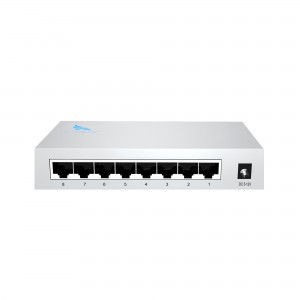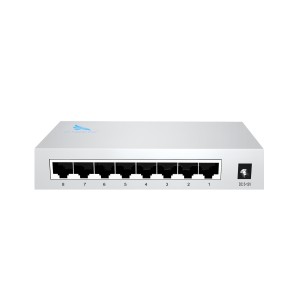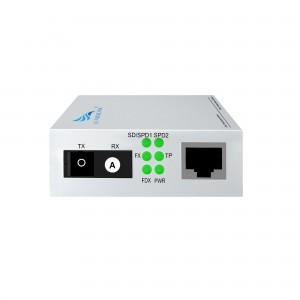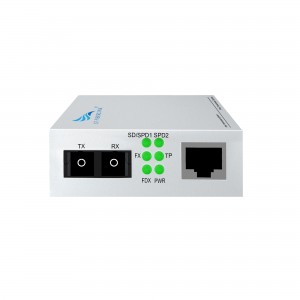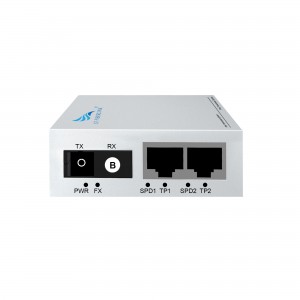5-port 10/100M Media Converter (Single-mode Dual-fiber SC)
5-port 10/100M Media Converter (Single-mode Dual-fiber SC)
Product Features:
Introducing a Revolutionary Optical Media Converter: A Portable Solution for All Your Networking Needs
Are you tired of dealing with slow and unreliable internet connections? Looking for a reliable, efficient solution to enhance your network performance? Look no further! Huizhou Changfei Optoelectronics Technology Co., Ltd. is proud to launch our latest innovative product – optical 4 electrical single-mode dual-fiber transceiver!
In YOFC, we are committed to providing cutting-edge, high-performance communication equipment. With our expertise in 5G technology and fiber optic transceivers, we have developed this state-of-the-art media converter to meet all your networking needs.
The true excellence of our media converters is their versatility. It combines the functions of fiber optic media converter, Ethernet fiber converter and portable fiber converter with unmatched convenience and flexibility. Whether you’re in a business environment, an educational institution, or on the go, this device is the perfect choice.
Our media converters are compact and lightweight, making them extremely portable so you can easily take them with you wherever you go. Plus, its IP30 rating ensures durability against dust, moisture, and other environmental elements. Say goodbye to worrying about damage from harsh conditions!
Optical 4 electrical single-mode dual-fiber media converters can operate efficiently with external power. Low power consumption ensures cost-effectiveness and minimizes energy consumption. Rest assured, this device will not only enhance your network performance, but also contribute to a greener planet.
One of the outstanding features of our media converters is the 4 digit dial. This user-friendly interface allows for seamless configuration and simplifies the connection process. No more complicated setup or technical jargon – just simple and straightforward connections. Experience a worry-free network like never before!
When you choose a product from Huizhou Changfei Optoelectronics Technology Co., Ltd., you can be confident in our commitment to quality and reliability. Our customer-oriented approach combined with rigorous testing procedures ensures that every product exceeds industry standards to provide you with an exceptional web experience.
In conclusion, if you are looking for an innovative high-performance solution to retrofit your network, the Optical 4 Electrical Single Mode Dual Fiber Media Converter is your answer. With its portable design, IP30 rating, low power consumption and user-friendly interface, this product will be a game changer for all your networking needs.
Upgrade your networking capabilities now! Please trust Huizhou Changfei Optoelectronics Technology Co., Ltd. to provide high-quality services and completely change your connection experience. Experience the future of networking with our incredible Optical 4 Electrical Single Mode Dual Fiber Media Converter.
What This Product Does
◇ The CF-1024SW-20 is a media converter designed to convert 100BASE-FX fiber to 100Base-TX copper media or vice versa. Designed under IEEE 802.3u 10/100Base-TX and 100Base-FX standards, the CF-1024SW-20 is designed for use with single-mode fiber cable utilizing the SC-Type connector. The CF-1024SW-20 supports longwave (LX) laser specification at a full wire speed forwarding rate. It works at 1310nm on both transmitting and receiving data.
◇ Other features of this module include the ability to be used as a stand alone device (no chassis required), Auto MDI/MDI-X for TX port, and front panel status LEDs. The CF-1024SW-20 will transmit at extended fiber optic distances utilizing single-mode fiber up to 20 kilometers.
Other Features
◇ In addition, the media converter can be used as a standalone device for automatic MDI/MDI-X in the TX port, where duplex mode is automatically negotiated.
technical parameter:
|
Model |
CF-1024SW-20 | |
| Interface Characteristics | ||
|
Fixed Port |
4* 10/ 100Base-TX RJ45 port 1* 155M uplink SC fiber port |
|
|
Ethernet Port |
10/ 100Base-TX auto-sensing, full/half duplex MDI/MDI-X self-adaption |
|
|
Twisted Pair Transmission |
10BASE-T: Cat3,4,5 UTP(≤100 meter) 100BASE-T: Cat5e or later UTP(≤100 meter) |
|
| Optical Port | Default optical module is single-mode dual-fiber 20km, SC port | |
| Wavelength/Distance | single mode: 1310nm 0~40KM ,1550nm 0~120KM | |
| Chip Parameter | ||
| Network Protocol | IEEE802.3 10BASE-T, IEEE802.3i 10Base-T,
IEEE802.3u 100Base-TX, IEEE802.3u 100Base-FX, IEEE802.3x |
|
|
Forwarding Mode |
Store and Forward(Full Wire Speed) |
|
|
Switching Capacity |
1Gbps |
|
|
Buffer Memory |
0.744Mpps | |
|
MAC |
1K | |
|
LED Indicator |
Fiber | SD/SPD1 (green) |
| rate | SPD2: 10/ 100 (green) | |
| Data | FX(green)/TP (green) | |
| FDX (green) | ||
| Single / duplex | ||
| Power | PWR (green) | |
| Power | ||
| Working Voltage |
AC:100-240V |
|
|
Power Consumption |
Standby<1W, Full load<4W |
|
|
Power Supply |
DC:5V/2A industrial power supply |
|
| Lightning protection &Certification | ||
| Lightning protection | Lightning protection: 4KV 8/20us, Protection level: IP30 | |
| Certification | CCC;CE mark, commercial; CE/LVD EN60950;FCC Part 15 Class B; RoHS | |
| Physical Parameter | ||
| Operation TEMP | -20~+55°C;5%~90% RH Non condensing | |
| Storage TEMP |
-40~+85°C;5%~95% RH Non condensing |
|
| Dimension (L*W*H) | 94mm* 71mm*27mm | |
| Installation | Desktop, CF-2U14 slot rack | |
Product Size:
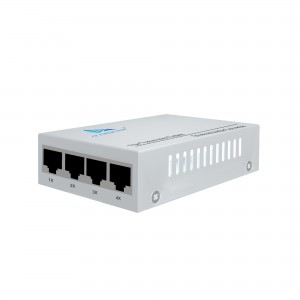
Product application diagra:

How to choose a fiber optic transceiver?
Optical fiber transceivers break the 100-meter limitation of Ethernet cables in data transmission. Relying on high-performance switching chips and large-capacity caches, while truly achieving non-blocking transmission and switching performance, they also provide balanced traffic, isolation and conflict. Error detection and other functions ensure high security and stability during data transmission. Therefore, fiber optic transceiver products will still be an indispensable part of actual network construction for a long time. So, how should we choose fiber optic transceivers?
1. Port function test
Mainly test whether each port can work normally in the duplex state of 10Mbps, 100Mbps and half-duplex state. At the same time, it should be tested whether each port can automatically select the highest transmission speed and automatically match the transmission rate of other devices. This test can be included in other tests.
2. Compatibility test
It mainly tests the connection ability between the optical fiber transceiver and other devices compatible with Ethernet and Fast Ethernet (including network card, HUB, Switch, optical network card, and optical switch). The requirement must be able to support the connection of compatible products.
3. Cable connection characteristics
Test the fiber optic transceiver’s ability to support network cables. First, test the connection ability of Category 5 network cables with lengths of 100m and 10m, and test the connection ability of long Category 5 network cables (120m) of different brands. During the test, the optical port of the transceiver is required to have a connection capability of 10Mbps and a rate of 100Mbps, and the highest must be able to connect to a full-duplex 100Mbps without transmission errors. Category 3 twisted pair cables may not be tested. Subtests can be included in other tests.
4. Transmission characteristics (transmission loss rate of data packets of different lengths, transmission speed)
It mainly tests the packet loss rate when the optical fiber transceiver optical port transmits different data packets, and the connection speed under different connection rates. For the packet loss rate, you can use the test software provided by the network card to test the packet loss rate when the packet size is 64, 512, 1518, 128 (optional) and 1000 (optional) bytes under different connection rates. , the number of packet errors, the number of packets sent and received must be more than 2,000,000. Test transmission speed can use perform3, ping and other software.
5. The compatibility of the whole machine to the transmission network protocol
It mainly tests the compatibility of fiber optic transceivers to network protocols, which can be tested in Novell, Windows and other environments. The following low-level network protocols such as TCP/IP, IPX, NETBIOS, DHCP, etc. must be tested, and the protocols that need to be broadcast must be tested. Optical transceivers are required to support these protocols (VLAN, QOS, COS, etc.).
6. Indicator status test
Test whether the status of the indicator light is consistent with the description of the panel and the user manual, and whether it is consistent with the current status of the fiber optic transceiver.








